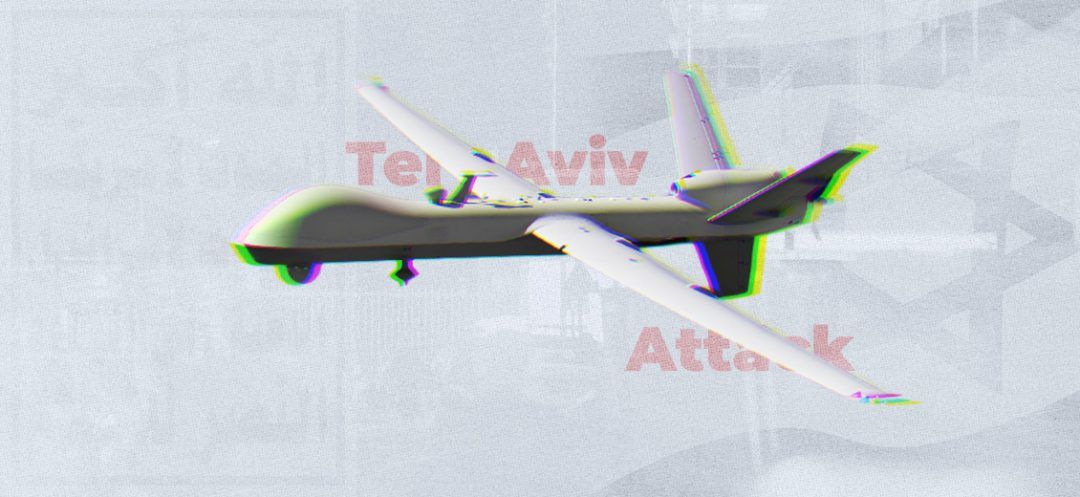- Home
- War in the Middle East
- Tel Aviv Attack: Luck or New Military Technology?

After nine hours and 2,000 km, the “Jaffa” drone, launched at dawn toward Tel Aviv in an attack claimed by the Yemeni Houthis, evaded interception. Was it luck or new military technology?
It is 3:10 AM. An explosion occurred at Hayarkon, at the corner of Ben-Yehuda Avenue and Shalom-Aleichem Street, near the local branch of the US consulate, the embassy being relocated to Jerusalem in 2019. According to preliminary reports, one person has been killed and about ten others injured, six 0f them sustaining psychological chocs.
The Samad-3 drone, an Iranian-made model with a declared range of 1,500 to 2,000 kilometers, was detected but not intercepted. It seems to have been developed to evade the interception systems of the Hebrew State. According to Mohammed el-Bacha, a researcher at the Navanti Group, the distance between Saada, the Houthi stronghold in Yemen, and Tel Aviv is about 1,850 kilometers. The Houthis confirmed on Friday that the drone, named Jaffa, was undetectable by radar and flew at low altitude over the sea.
“The fact that it traveled nearly 2,000 kilometers without being intercepted is a significant military achievement for the Yemeni ‘Resistance’ Axis,” notes El-Bacha. Retired General Raouf Sayah agrees, highlighting that “Houthi weaponry, primarily sourced from Iran, has seen considerable advancements.” He adds that it’s not surprising a drone like the Samad-3 could reach its target. Advanced technology means that even a detected drone can achieve its mission. How? It might not have been classified as “hostile” or “intrusive,” possibly providing misleading information about its trajectory or nature, explains General Sayah.
Since no warning sirens were triggered, Israeli forces, who have ruled out a malfunction in detection systems, suggest a “human error” despite the drone being spotted. An investigation is now underway by Israeli authorities to clarify the matter and “hold those responsible accountable.”
A Stroke of Luck?
If the Houthis are talking about a so-called "victory" it is because one of their drones had reached Tel Aviv for the first time. However, some observers believe it may be due to hazard. Israeli defense systems have intercepted thousands of projectiles since the Gaza war began. According to Jean Sebastien Guillaume, founder of Celtic Intelligence, it was a “stroke of luck” for the Houthis, who, with Iranian encouragement, attempted a failed coordinated attack with Iraqi militias. Moreover, it is noteworthy that on July 15, “Iran’s new president Massoud Pezeshkian, contacted Hamas leader Ismail Haniyeh, and the following day, reached out to Mehdi Machat, head of the Houthi Supreme Political Council, to assure Iran's proxies of the continuity of the 'axis of resistance' after the election of the Iranian president,” Guillaume added. Additionally, a drone from Iraq was downed outside Israeli airspace on the night of Thursday to Friday, which could support the theory of a coordinated attack.
“I believe it is nearly impossible that the attack came from Yemen,” says retired General Maroun Hitti, who suspects the drone was launched from Iraq, Lebanon or Syria. “The Houthis claimed responsibility to mislead and avoid retaliation against any of these countries,” he explains. According to an Israeli military official, “It is unlikely the attack originated from northern Israel,” thus ruling out Lebanon as a source. The official added, “We are not, however, dismissing any possibilities.”
When asked if this attack will represent a turning point in the October 7 ongoing conflict, General Sayah anticipates that similar attacks may reoccur. He attributes this potential escalation to the parties involved seeking to apply greater pressure to secure more favorable terms in the ongoing negotiations.
Read more




Comments